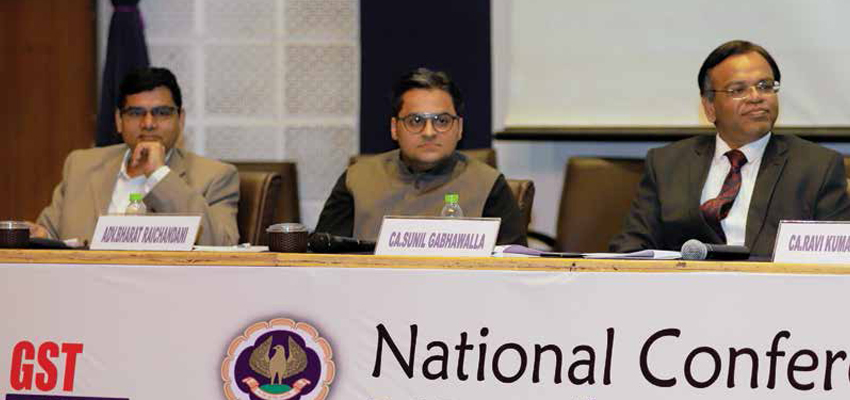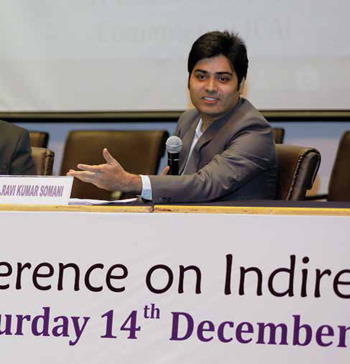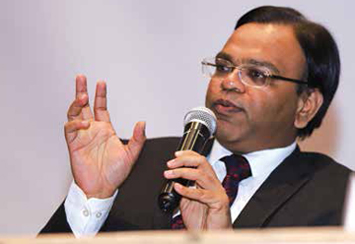GST, Beyond GST and GST 2.0

The genesis of Goods and Services Tax (GST) was introduced in the historic Budget of 2006. However, it came into effect on July 1, 2017, and since then it has taken the country by storm. It does have its pros and not forgetting it does come with a few shortcomings as well. During the recent National Conference on Indirect Taxes, “GST Gyan Manthan”, held at Sri Balaji University, Pune, (SBUP) an esteemed panel including CA. Ravi Kumar Somani (Moderator), CA. Sunil Gabhawalla, Adv. Bharat Raichandani and CA. Rajesh Shukla, discussed various critical issues revolving around GST. Corporate Citizen reports
Ravi Kumar Somani: When we come to this varied topic of GST, the first thing that comes to my mind is its levy aspect. As we all know that levy under GST is supply and it’s defined in a very inclusive manner. However, today we have come to a point where a conclusive meaning of supply is unknown. My question to the estimated panel is does any sort of debt take a form of supply which is viable for GST? Is there something more to it? Where do we draw a line? Frankly, there are just too many questions involved. Also, we would like to know if various penalties and debts to suppliers and customers, which is generally called as liquidated damage, is liable for GST as well. Talk us through the various aspects related to it.

Sunil Gabhawalla: Might i say, Ravi has brought up some interesting questions. and few of them go to the core of the entire concept of the levy. Coming to the topic, many of us here believe that word the supply comes with a proper definition. However, let me make a strong statement here. The GST law does not define supply. What Section 7 under GST provides is only the scope of supply. Of course, there’s a tremendous difference between the scope and definition of supply.
What i want to say is, there can be a law wherein a term is not defined. My understanding is that the word supply itself is not defined, what Section 7 gives is, it lays down the restrictions what all supplies can be taxed. in that sense, Section 7 is very restrictive. if we look that context in the section and if we are going to interpret as its scope of supply rather than its definition, things will fall in place. The three things mentioned in the supply are in fact the limited things that can be taxed and everything is supply as we generally understand.
to give some guidance on a term’s scope and definition, the recent Bombay High Court decision in the Bai Mamubhai trust, comes in very handy. it gives in-depth analysis and principles of what a term should constitute are clearly stated. and anyone who wants to practice long term in indirect act should definitely follow this. What the decision states is when supply comes into the picture, it should come out from an enforceable contract.
Even, for instance, let’s go back to the income tax act, Section 224 which defines the word income. it has a Section 5 that separately defines its scope. and when you draw an analogy from both its scope and definition things will fall in place. Before moving further, let’s keep a few things in mind. The term ‘supply’ itself is not defined and the word ‘include’ does not give the liberty to tax all incomes and debts. and also, there is a requirement of an enforceable contract with a dominant intention.
Now, coming to point of the liquidated damages. For instance, as a customer or client, i’m taking service from an establishment. in case of a violation, i decide to deduct an amount from their payment. So now the question arises if that deducted amount is an element of a service or supply made by the company to me. again, we will have to go back to the basic principles, where i have to look at the composite contract. i need to look at the various aspects revolving around the same contract. The answer is very clear, in all this matter there is typically a single contract. And liquidated damage comes out as an incident of that contract in certain eventualities.
Bharat Raichandani: The main question here should be a proper understanding of who the supplier is and the proper agreement of the goods that will be supplied by the supplier. and only then it should be termed as supply. it is the contract of supply which is sought to be taxed. There has to be an agreement between the supplier and the receiver. in any given case, there has to be a clear understanding of what the supplier is supplying and what the receiver is going to receive. Revenue cannot rewrite contract as per parties. These are all contract-based taxations. i’m of the opinion that liquidated damages, penalties and others will not constitute as supplies. However, if i recover that from the customer and if there’s a solid agreement, in that case, it that could be construed as supply. Even if it is not a part of the principal supply, it can be a part of an independent supply. and today, there are no classification disputes.
Rajesh Shukla: Considering all the factors, the topic of supply is quite debatable. Some can agree with it, while others can feely disagree with it. Generally, we tend to go with the most practical view-whether it’s a cost-neutral or it involves cost. and if it’s cost-neutral, instead of going into a litigation mode, sought out the most practical way, or else it will continue endlessly.
Ravi: The crux of this matter is, merely no one agrees at the start of the contract to not to do certain things, the agreement is to cover everything. But if in the process, some things are not done, then the penalties and debts cannot be treated as independent supply.
My understanding is that the word supply itself is not defined, what Section 7 gives is, it lays down the restrictions what all supplies can be taxed
— CA. Sunil Gabhawalla
Ravi: One of the other most disputed topics is supply between head office and branches. I would like to know if there should be a cross billing between HO and branches when service comes into the picture. Walk us through all the facets that should be included...

Bharat: There essentially are three parts when it comes to supply or services between HO and branches. We need to consider and understand all permutations and combinations of supply or services between HO and branches. Once that is sorted, one needs to know if the supply or service is liable to tax. and if it liable to tax then what is its value?
Further, let us first understand the concept of a distinct person and let’s not stretch it beyond a point. This concept was introduced only to tax stock transfers. Because of the Vat regime or Sales tax Regime, stock transfers were never viable for tax. and also, due to the diversity in our country, one nation, one GST does not work. Even under GST, the State Legislative is sovereign. Erstwhile, there was no tax on stock transfers because it was a supply between two same entities and different states. today, we have different taxes in different states.
Based on the fact that GST is a destination-based consumption tax, Branch a (for instance) will pay the tax for stock transfer and Branch B will take credit of that, which is why there was no revenue implication. it works on a simple fact that where the goods are destined, the tax must flow with the goods. and where the goods are consumed that state should enjoy the tax. Just to ensure this, the concept of a distinct person was introduced. So that they ensure that the tax travels with the goods, which happens to be another important principle.
When it comes to services, the main point that should be noted is, if there is any supply between the head office to the branch office. The problem arises if there are profit centres within a centre. i personally feel that this situation does not come undersupply, hence it should not be taxed. if there are practical challenge or issues, and if credit is available then one should go ahead with it. Or else it will result in disputes.
Another issue that arises is how can one value these supplies. When there is no agreement for services, it does not fall under the supply bracket. in fact, there’s a Schedule under GST, that states if there’s a supply between two distinct people even without consideration, it’s still tagged as supply. it’s a common mistake where people consider Schedule i-iii as charging section. as a matter of fact, the charging section is Section 9.
Ravi: Valuation of supply under GST is another vast topic. Rajesh, can you touch upon a few important points that should be taken under consideration?
Rajesh: Section 28 under the GST law states that:
The value of the supply of goods or services or both between distinct persons as specified in sub-section (4) and (5) of section 25 or where the supplier and recipient are related, other than where the supply is made through an agent, shall-
- Be the open market value of such supply;
- If the open market value is not available, be the value of supply of goods or services of like kind and quality;
- If the value is not determinable under clause (a) or (b), be the value as determined by the application of rule 30 or rule 31, in that order:
Provided that where the goods are intended for further supply as such by the recipient, the value shall, at the option of the supplier, be an amount equivalent to ninety per cent of the price charged for the supply of goods of like kind and quality by the recipient to his customer not being a related person:
Provided further that where the recipient is eligible for the full input tax credit, the value declared in the invoice shall be deemed to be the open market value of the goods or services.
Our view is that, for supply or service of goods, if that particular item is available at the creditable item at the interim location, then definitely we have the protection of Section 28. And if the item is not eligible for supply, then we should follow the Valuation Rule.
Let us first understand the concept of a distinct person and let’s not stretch it beyond a point. This concept was introduced only to tax stock transfers
— Adv. Bharat Raichandani
Ravi: If there is Input Service Distributor (ISD) under GST, then the cross charge is not required. And if the cross charge is done, you need not require the ISD registration. Sunil, can you explain the fine line between these two?

Sunil: One of the views that are floating is ISD and cross chargers are mutually exclusive to each other. One needs to understand the context in which the goods have been brought. As far as the supply of services is concerned, if there’s a precedent, then you have to take into consideration the Schedule I of GST. It should be looked as a benefit to the consumer, rather than considering it as an obligation.
Rajesh: Completely agreed. I sometimes feel these cross chargers should be used for our advantage.
Bharat: In fact, according to me, ISD was not required. Once GST has come, ISD was a concept for transferring credit for services, because they did not have goods and services then. Revenue cannot thrust any option on you. It’s your choice, it’s your option.
Ravi: Pertaining to the Input Tax Credit, elaborate on the factor of canteen or outdoor catering services and if they can be covered under food and beverages.
Rajesh: This is a very practical issue that most of the companies are facing. However, the recent amendment that took place in February 2019 states that if the calculations are provided as per the obligation of law then the credit is available. For instance, if the canteen is in a factory then the credit is available. In that case, one should plan it accordingly. If one recovers the money, it will cost them 10 per cent. The service provider charges them five per cent and once that is recovered it becomes related party transaction leading one to add the open market value. Here, the best way is to do a cost analysis.
Ravi: The way GST laws are changing these days it becomes inevitable to say that we would be entering the realm of GST 2.0 soon.
Rajesh: GST is something that directly impacts the industry. The entire supply chain has to gear up for this change. Without getting the IRN, one is not allowed to move their goods. Just imagine the kind of challenges we are facing these days. At every quarter, invoices have to be uploaded as per the GST. And if that is not done the supply gets disrupted. And in the coming months, a lot of changes are expected. The only thing we can do is embrace it. And when it comes to e-invoicing, they themselves are not clear about it. Sunil: The issues here is we are moving way too quickly into other things before even settling in. What we are looking for is stability and proper guidelines which can ease the process. When you are infusing technology with GST, fasten the process so as the results are visible on the go.